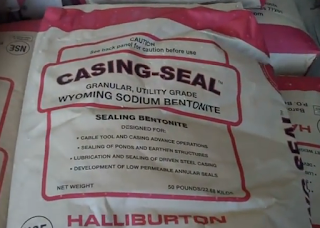Bentonite is an absorbent form of clay. There are several types named after their dominant element, such as potassium (K), sodium (Na), calcium (Ca), and aluminum (Al).
Sodium bentonite expands when wet, absorbing as much as several times its dry mass in water. Because of its excellent colloidal properties, it is often used in drilling mud for oil and gas wells and boreholes for geotechnical and environmental investigations. The property of swelling also makes sodium bentonite useful as a sealant, since it provides a self-sealing, low permeability barrier. It is used to line the base of landfills and tanks/ponds.
There are tests to run to see if you need this type sealant when making a pond. One is to get a five gallon bucket, drill holes in the bottom, put inch or two of dirt from the bottom of your pond and fill the bucket with water. If the dirt seals the holes and water does not get out then this type of product might not be necessary.
I've seen individuals suggest putting 2-3 lbs per square foot. This makes it about one inch thick. Since the bottom of the tank is not flat, you can't just measure the surface area of the tank when determining your square footage. Once it is evenly spread on the bottom, you should till it in and then compact the ground. This makes it essentially part of the floor of the tank/pond rather than just a layer at the bottom.
Halliburton makes a product for this purpose which is called Casing Seal.

No comments:
Post a Comment